Papers by Peter Orji Uvere

International Journal of Food Sciences and Nutrition, Jul 1, 2017
Iodization of salt is an effective and sustainable approach to prevent and control iodine deficie... more Iodization of salt is an effective and sustainable approach to prevent and control iodine deficiency. Currently potassium iodate and This study investigated the effect of degerming, malting, ashing and emulsification on the chemical properties of the respective food components used in formulating fortified maize-bambara groundnut and maize-cowpea complementary foods. The chemical properties of the processed fortifying food base components were determined by standard methods. Degerming led to 14.09%, 6.66%, 16.16% and 0.18% losses in calcium, iron, zinc and pro-vitamin A. Malting led to 7.27 and 7.94%; 9.25 and 3.38%; 2.71 and 4.08 % losses in calcium, iron and zinc contents of bambara groundnut and cowpea respectively but increased their vitamin A. Ashed Hibiscus sabdariffa had calcium content of 5.6967gkg-1, iron (1.947 gkg-1) and zinc content (7.333 gkg-1). Emulsification of palm oil with Brachystegia eurycoma seed flour led to 57% loss in pro-vitamin a content. Processing affected the chemical properties of components used in formulating maize-bambara groundnut and maize-cowpea complementary foods hence there is need for processes modification.
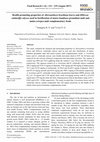
Food Research, Jun 28, 2017
The study evaluated the chemical and antioxidant properties of Alternanthera brasiliana leaves an... more The study evaluated the chemical and antioxidant properties of Alternanthera brasiliana leaves and Hibiscus sabdariffa calyces used in iron and zinc fortification of maizebambara groundnut malt and maize-cowpea malt complementary foods. A. brasiliana leaves and H. sabdariffa calyces were freshly harvested, dried at 50 o C for 48 hours and analyzed for the relevant chemical components and antioxidant activities. The vitamin A content was 6996 and 745.6 µgRE/kg while the vitamin C was 238.26 and 294.78 mg/kg respectively. The aqueous extracts of A. brasiliana and H. sabdariffa calyces contained 509.5 mg/kg and 5234.72 mg/kg of alkaloids, 1545 mg/kg and 384 mg/kg of anthocyanins, 767.3 and 235.83 mg/kg of carotenoids, 14,702.8 and 26,428.3 mg/kg of phenols, 1043.5 and 897.63 mg/kg steroids and 462.0 mg/kg and 1006.5 mg/kg of flavonoids respectively. A. brasiliana and H. sabdariffa extracts had concentration-dependent DPPH activity with IC 50 of 1.76 mg/ml and 5.745 mg/ml, nitric oxide scavenging activity with IC 50 of 0.675 mg/ml and 3.976 mg/ml while the ferric reducing power had an absorbance range of 0.5-0.982 and 0.959-0.986 respectively. The study revealed that A.brasiliana leaves and H. sabdariffa calyces contain components that will impact positively on the health of the infants when used to formulate complementary foods.

Nigerian Food Journal, 2012
This study was undertaken to determine the possibility of producing acceptable 'abacha' from drie... more This study was undertaken to determine the possibility of producing acceptable 'abacha' from dried chips. The 'abacha' slices were processed from dried cassava chips and fresh roots of four cassava varieties, TMS 98/2101, NR/87184, TMS 97/4779 and NR87184. The proximate composition, chemical and sensory properties as affected by the processing method and variety were evaluated. The proximate composition of the 'abacha' (on dry basis) showed moisture content range of 9.53-10.48%, protein 1.07-1.66%, ash 2.06-2.56%, fibre 1.72-1.95, fat 0.39-0.58% and carbohydrate content of 83.59-85.05%. The chemical composition of the wet 'abacha' slices showed pH of 5.60-5.80, total titratable acidity (TTA) of 0.047-0.063, and hydrogen cyanide (HCN) value of 7.80-10.41 mg/100 g. Generally, the TTA of the 'abacha' samples was not significantly (p > 0.05) affected by the method of processing 'abacha' and the variety used. Drying the wet 'abacha' reduced the pH to 5.20-5.30, increased the TTA to 0.213-0.230% and further reduced the HCN content to 7.32-8.63 mg/100 g. The HCN of all the 'abacha' samples processed from dried chips were significantly (p < 0.05) lower than the HCN of 'abacha' processed from fresh cassava root in some of the varieties. The lower sensory scores for 'abacha' made from dried chips shows that they were inferior to the ones from fresh cassava, although they were also accepted by the consumers. It also compared favourably with the 'abacha' processed from fresh cassava root in chemical qualities. This shows that when the need arises 'abacha' slices can be processed from dried cassava chips.

African Journal of Food Science, Sep 30, 2014
This study was undertaken to evaluate the effect of processing methods on the quality of abacha s... more This study was undertaken to evaluate the effect of processing methods on the quality of abacha slices. Abacha slices were produced from cassava (TMS 97/4779) roots by four different methods. The abacha processing methods investigated were of different peeling, boiling, slicing and soaking methods. Also, raw cassava flour, which was peeled, sliced and dried (PSD) was produced. The sensory properties and yield of abacha, the chemical and physical properties of the flour from the dried abacha and raw cassava flour were determined. The sensory properties of the fresh abacha were evaluated which showed that boiled, peeled and sliced sample (BPS) was most preferred. The yield of the abacha ranged from 29.17-39.13%. Significant differences (p<0.05) were observed in the proximate composition of the samples. The processing methods significantly affected the swelling index and water absorption capacity of the abacha flour. PSD sample showed the highest value in swelling index and water absorption capacity. The cyanide content, which ranged from 4.20-7.20 mg/kg, was below the recommended safety level of 10 mg/kg HCN. The processing methods significantly (p<0.05) affected the pasting properties of the abacha flour except peak viscosity and peak time.
Journal of the Science of Food and Agriculture, Nov 21, 2022
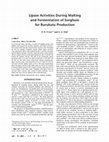
Journal of The Institute of Brewing, 2002
Local red and white, and SK 5912 varieties of sorghum grains were malted, and assayed for amylase... more Local red and white, and SK 5912 varieties of sorghum grains were malted, and assayed for amylase, diastatic and lipase activities. The 5-day malts from the red and white varieties were fermented for 48 h to produce burukutu, during which, lipase activities were monitored. Malt values peaked on day 5, and the red malts had the highest diastatic activities while the white variety had the lowest. Lipase activity in the malts peaked on day 4 with the red having the highest activity. The pH of the fermenting gruels decreased from 5.33 and 5.35 and levelled off at 3.88 and 3.85 for the red and white malts respectively. During fermentation, lipase activity peaks were detected at 0 h, 21 h and 45 h for the red malt with the highest peak at 45 h. The peak fermentation times for lipase activity in the white malt was at 0 h, 21 h and 48 h with the highest peak at 48 h. Lipase activity within the first 39 h was higher in the white gruel. Sorghum malt lipase from the red and white varieties may consist of three isoforms, two of which may have activity optima in the acidic pH range.

International Journal of Basic and Applied Sciences, Dec 6, 2013
Background: Overweight and obesity in adolescence are powerful risk factors of chronic diseases i... more Background: Overweight and obesity in adolescence are powerful risk factors of chronic diseases in adulthood. Objective: To determine the prevalence of overweight, obesity and thinness among adolescents in rural and urban areas of Enugu State, Nigeria. Method: A total of 500 adolescents (10-19 years) consisting of 220 males and 280 females were randomly selected from 12 study schools in the State. A structured questionnaire was used to collect data on background information of the adolescents. Anthropometric measurements (weight and height) of the adolescents were obtained, and used to calculate the Body Mass Index (BMI). The BMI were categorized into obesity, overweight, normal and thinness using the International Obesity Task Force (IOTF) reference and the WHO adult BMI classification for adolescents up to 19 years. The data obtained were coded and analyzed into means, frequencies, percentages and chi-square using the Statistical Package for Social Sciences (SPSS), version 17. Results: The prevalence of overweight, obesity and thinness among adolescents were 7.5%. 2.1% and 13.9%, respectively. The prevalence of obesity among the adolescents in urban areas was 4.1% while none of the rural adolescents was obese. There was a higher prevalence rate of obesity among males than among females. Conclusion: Obesity is creeping into traditional societies as evident in this study.
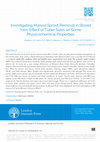
The study focused on manual sprout removal and effect of tuber sizes on some physicochemical prop... more The study focused on manual sprout removal and effect of tuber sizes on some physicochemical properties of the stored yams. Yam variety, Ameh (Dioscorea rotundata) with different tuber sizes ≤ 0.5 Kg, 0.6-0.9 Kg and ≥ 1.0 Kg for small (SS), medium (MS) and big(BS) sizes, respectively, were used. The primary nodal complex (PNC) was removed using three methods: hand picking, half cutting and full cutting. Tubers were stored on shelves for 16 weeks in a yam storage laboratory at National Root Crops Research Institute, Umudike, Nigeria. Physicochemical parameters determined were temperature, relative humidity, sprout count, weight loss (WL), dry matter (wet basis), starch yield, amylose, reducing sugars (TRS), water absorption capacity (WAC) and bulk density (BD). Weight loss significantly (p>0.05) increased with storage. The mean dry matter (DM) across sprout removal methods showed significant difference (p>0.05), and lowest in big tubers (30.77%). DM was lowest in control and hand picking at 16 weeks. Starch yield, amylose and TRS were highest in the MS tubers. Values of MS tubers for starch, amylose and TRS were 25.88%, 13.11% and 3.11%, respectively. Starch, amylose and sugars decreased with storage. There was a significant difference (p>0.05) in starch yield, amylose and sugars across tuber size and across storage period. Mean values of tubers for manual sprout removal methods during storage on BD and WAC were significant (p>0.05) and highest in BS tubers (0.47 g/ml BD and 2.00 g/ml WAC).

Food Research, Aug 19, 2017
The study investigated the changes in crude protein content, moisture, fat, total sugar, and thio... more The study investigated the changes in crude protein content, moisture, fat, total sugar, and thiobarbituric acid (TBA) value) of instant Kunun zaki powder packaged in polyethylene and stored for 90 days. Instant Kunun zaki powder was prepared from millet-cowpea malt (MC m) and millet-soybean malt (MS m) by steam heating, packaged in polypropylene (12x18cm), sealed and stored at room temperature (28±0.3 o C) and room humidity (45%) for 90 days during which the chemical properties were monitored every 30 days using standard procedures. The moisture content of MC m and MS m increased by 66.61 and 65.77%; the sugar increased by 28.90% and 11.33%; the fat content increased by 0.21 and 0.45%; the TBA content of MC m and MS m increased by 0.0002 and 0.0001 mg/100g while the protein content decreased by 15.56% and 17.07% respectively. The study has revealed that storage of instant Kunun zaki flours in flexible packaging material at ambient temperature resulted in an increase in the chemical parameters except for protein which decreased hence there would be needed to use a better material for storage.
Journal of Food Science and Technology
Globalization and Health, 2012
Objective: To document the prevalence of overweight, obesity and thinness in 9-10 year old childr... more Objective: To document the prevalence of overweight, obesity and thinness in 9-10 year old children in Mauritius. Methods: 412 boys and 429 girls aged 9-10 years from 23 primary schools were selected using stratified cluster random sampling. All data was cross-sectional and collected via anthropometry and self-administered questionnaire. Outcome measures were BMI (kg/m 2 ), prevalence of overweight, obesity (International Obesity Task Force definitions) and thinness (low BMI for age). Linear and logistic regression analyses, accounting for clustering at the school level, were used to assess associations between gender, ethnicity, school location, and school's academic performance (average) to each outcome measure.
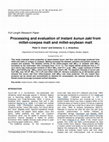
African Journal of Food Science, 2011
This study evaluated some properties of steam-heated kunun zaki flour and beverage produced from ... more This study evaluated some properties of steam-heated kunun zaki flour and beverage produced from millet and malts of cowpea or soybean. Malting increased the diastatic activities and protein content of cowpea and soybean. The diastatic activity of the millet-cowpea malt (MC m ) or soybean malt (MS m ) increased as the solid-water ratio increased from 1:0 to 1:3. The instant blends produced from a 1:1 (w/v) slurry had crude protein contents of 203.4 (MC m ) and 317.1 g kg -1 (MS m ), sugar contents of 0.6444 (MC m ) and 0.6378 g kg -1 (MS m ), which were higher than millet's (M). The apparent viscosity of kunun zaki from MS m was 125 cP, MC m (121.3 cP) and millet (1605 cP). Sensory evaluation by an 80-member panel showed that kunun zaki from millet-soybean malt (MS m ) was most preferred. The dry instant flour products can be stored and reconstituted on demand for consumption; the reduced viscosity of the blends would encourage increased nutrient densities.
Fermentation Technology, 2013
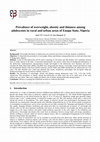
International Journal of Basic and Applied Sciences, Dec 6, 2013
Background: Overweight and obesity in adolescence are powerful risk factors of chronic diseases i... more Background: Overweight and obesity in adolescence are powerful risk factors of chronic diseases in adulthood. Objective: To determine the prevalence of overweight, obesity and thinness among adolescents in rural and urban areas of Enugu State, Nigeria. Method: A total of 500 adolescents (10-19 years) consisting of 220 males and 280 females were randomly selected from 12 study schools in the State. A structured questionnaire was used to collect data on background information of the adolescents. Anthropometric measurements (weight and height) of the adolescents were obtained, and used to calculate the Body Mass Index (BMI). The BMI were categorized into obesity, overweight, normal and thinness using the International Obesity Task Force (IOTF) reference and the WHO adult BMI classification for adolescents up to 19 years. The data obtained were coded and analyzed into means, frequencies, percentages and chi-square using the Statistical Package for Social Sciences (SPSS), version 17. Results: The prevalence of overweight, obesity and thinness among adolescents were 7.5%. 2.1% and 13.9%, respectively. The prevalence of obesity among the adolescents in urban areas was 4.1% while none of the rural adolescents was obese. There was a higher prevalence rate of obesity among males than among females. Conclusion: Obesity is creeping into traditional societies as evident in this study.

Plant Foods For Human Nutrition, Feb 1, 1999
Red palm oil was tested for the reactivity of its components with CN − , and alkaline picrate as ... more Red palm oil was tested for the reactivity of its components with CN − , and alkaline picrate as the color developing reagent. Palm oil components have a low-level absorbance at 490 nm which is reduced significantly (p 0.01) after reaction with CN − . Hydrolysis of palm oil components, and reaction of the hydrolysis products with CN − significantly increased the absorbance at 490 nm. In contrast, after reaction of palm oil with alkaline picrate, the absorbance at 490 nm is very high; this is reduced significantly by reaction with CN − , hydrolysis with 0.2 M NaOH , and reaction of the hydrolysis products with CN − before treatment with alkaline picrate. The results indicate that palm oil component(s) sequester CN − into a complex which may not be correctly estimated during cyanide quantification, resulting in the absence, or low levels of cyanide in palm oil-fried gari as earlier reported.
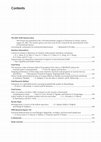
Food and nutrition bulletin, 2002
Grains of cowpea and maize and slices of fresh cassava, cocoyam, plantain, and yam were steep-fer... more Grains of cowpea and maize and slices of fresh cassava, cocoyam, plantain, and yam were steep-fermented in water, while flours from the same plant materials were fermented by backslopping for 24 to 30 hours. The pH and apparent viscosity of the gruels from the resulting flours were determined. Loss in weight due to fermentation was higher in fresh tubers than in dry grains. The pH of the flours decreased during fermentation. Measurements showed that the apparent viscosity only of gruels from flours produced by backslopping decreased after 24 hours. The apparent viscosity of gruels from steep-fermented flours was higher than that of the unfermented flours and those produced by backslopping. The apparent viscosity reduction of gruels from steep-fermented flours using amylase-rich flour (ARF) from five-day white sorghum malt was better with the prepared gruels than when applied to the flour-in-tap-water suspension before it was used to prepare gruels. Viscosity reduction using ARF was ...
Plant foods for human nutrition (Dordrecht, Netherlands), 1999
Germinated bambara groundnut was dried by three methods--oven-drying at 50 degrees C, in a solar ... more Germinated bambara groundnut was dried by three methods--oven-drying at 50 degrees C, in a solar drier at 38-42 degrees C, and sun drying at 28 +/- 2 degrees C. The samples were milled into flour, and made into 'okpa', a steamed gel. Flour yield increased only in oven-dried malts. The quality of the 'okpa' based on appearance and taste decreased with malting time; solar drying resulted in the poorest product because of its dark color.

Nigerian Journal of Nutritional Sciences, 2011
ABSTRACT Objective: The effect of fortification of maize-bambara groundnut complementary foods wi... more ABSTRACT Objective: The effect of fortification of maize-bambara groundnut complementary foods with Brachystegia eurycoma or potash emulsified red palm oil on the vitamin A content was studied. Materials and Methods: Fresh red palm oil:water emulsion (1:1, v/v) was stabilized with B. eurycoma flour or ground potash (1:1, w/v), dried and used to fortify maize-bambara groundnut infant formulae (1:3, w/w) before or after 72 hour backslopping fermentation. Fermented formulae were dried at 50oC for 12hr and analyzed for vitamin A content. Results:Vitamin A in fermented maize-bambara groundnut [(MB)f] and fermented maize-bambara groundnut malt [(MBm)f] flour blends were 33.01 and 41.17ìgRE/100g respectively while in the fortified blends, vitamin A content varied from 490.07-502.92 ìgRE/100g and 511.44-538.82 ìgRE/100g in potash-emulsified samples fortified pre- and post-fermentation respectively. In B. eurycoma-emulsified samples, it was 536.27-740.12 ìgRE/100g and 634.42-868.72 ìgRE/100g respectively. The maize-bambara groundnut malt [(MBm)f] flour blends fortified post-fermentation with B. eurycoma-emulsified red palm oil had the highest vitamin A content of 868.72 ìgRE/100g. Conclusion: Maize–bambara groundnut malt fortified post-fermentation with red palm oil emulsified with B. eurycoma had the highest vitamin A content over potash-emuksified samples and samples fortified prefermentation. B. eurycoma–emulsified palm oil could therefore serve as an effective food vehicle for incorporating vitamin A into complementary foods for infants. The fortified products had low moisture contents which could enhance storage stability.
Nutrition in Infancy, 2012
ABSTRACT Infancy is the developmental period that extends from birth until eighteen to twenty-fou... more ABSTRACT Infancy is the developmental period that extends from birth until eighteen to twenty-four months. It is a time of extreme dependence on adults. Many psychological activities are just beginning—language, symbolic thought, sensorimotor coordination and social learning, for example. This makes it necessary for conditions that may lead to irreversible faltering in linear growth and cognitive deficits to be addressed. Poor nutrition during this critical period is one such factor and contributes to significant morbidity and mortality in developing countries. Early detection of growth faltering and promotion of appropriate feeding practices are therefore important for prevention of malnutrition and the very survival of such children.

Journal of the Science of Food and Agriculture, 2000
ABSTRACT Grain sorghum of the red and white varieties was malted by steeping in water for 18 h, g... more ABSTRACT Grain sorghum of the red and white varieties was malted by steeping in water for 18 h, germinated over 5 days and kilned at 50 °C. The malts were analysed for amylase activities and cyanogenic potential and used to produce burukutu, an alcoholic beverage. The alcohol content of the burukutu was recovered by distillation and determined by the refractive index method. α-Amylase activity peaked on malting day 3 and was higher in the white malts. β-Amylase activity peaked on day 3 in the red malts and on day 4 in the white malts, but was higher in the red malts. Dhurrinase activity was highest on malting day 4, with a higher activity in the red malts. Kilning at 50 °C reduced the activities of these enzymes. The dhurrin content increased during germination and was consistently higher in the white malts, in which there was evidence of dhurrin mobilisation. In the red malts the dhurrin content increased during germination but decreased progressively after kilning; evidence of dhurrin mobilisation was apparent as from malting day 4. Burukutu produced from the red malts gave higher alcohol contents than that from the white malts. Maximum alcohol yields were obtained on malting day 3 in the red malts and on day 5 in the white malts.© 2000 Society of Chemical Industry









Uploads
Papers by Peter Orji Uvere